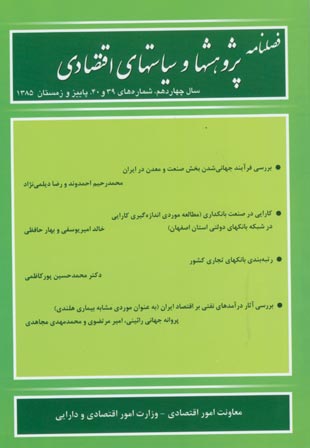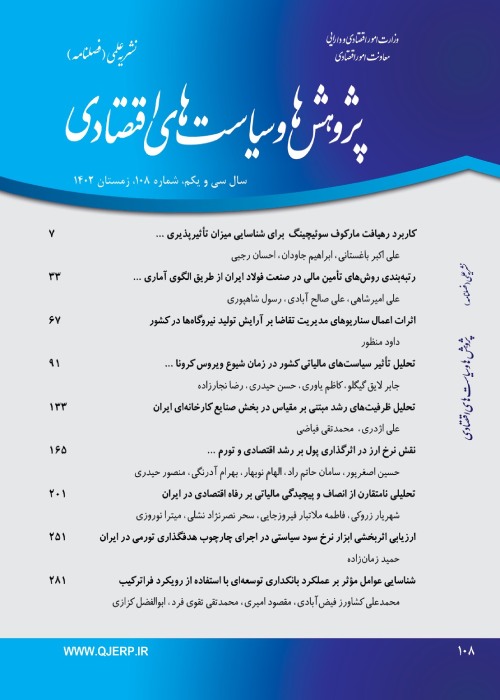فهرست مطالب

فصلنامه پژوهش ها و سیاست های اقتصادی
پیاپی 39-40 (پاییز و زمستان 1386)
- 144 صفحه،
- تاریخ انتشار: 1386/01/20
- تعداد عناوین: 4
-
صفحه 5از دهه 1990 میلادی تحولات اقتصاد جهانی به سوی یکپارچگی و همگرایی اقتصادها به شکل منطقه ای شدن پیش می رود. در سیر این تحولات جریانهای تجاری و سرمایه نقش مهمی دارند. به بیان دیگر، حرکت جهانی شدن اقتصاد با تحولات در تجارت بین الملل و بازار سرمایه همراه بوده است. در این مقاله با توجه به اهمیت و نقش بخش صنعت و معدن در ارتباطات گسترده پسین و پیشین با سایر بخشهای اقتصاد و نیل به توسعه اقتصادی، جهانی شدن اقتصاد در بخش صنعت و معدن ایران از نظر تجاری با استفاده از دو شاخص سطح تجارت بین الملل و ادغام تجارت بین الملل بررسی شده است. بر اساس مطالعه انجام شده رقابت تجاری در بخش صنعت، تا حدی فراتر از مرزهای داخلی پیش می رود اما بخش معدن از نظر رقابت بین المللی در سطح بالاتری قرار دارد، به طوری که در برخی فعالیتهای معدنی مزیت نسبی حاصل شده است.
کلیدواژگان: جهانی شدن، شاخص ادغام تجارت بین الملل، شاخص سطح تجارت بین الملل -
صفحه 27در نظریه اقتصادی، رشد و توسعه بنگاه حاصل از تولید مقدار بیشتری ستاده با مقدار معینی نهاده یا تولید مقدار معینی ستاده با مقدار کمتری نهاده و به عبارت دیگر افزایش کارایی و بهره وری است. در این مقاله پس از ارائه کلیاتی درباره مبانی نظری اندازه گیری کارایی براساس رویکرد نوین، تعریف و بررسی کارایی مبتنی بر مفهوم تابع تولید در اقتصاد خرد، به مبحث اندازه گیری کارایی در صنعت بانکداری می پردازد. گستره این مبحث شامل دو رویکرد تولیدی و واسطه گری در تعریف کارایی بانک، سه سطح مختلف تصمیم گیری درباره فروض انتخابی در اندازه گیری کارایی، شکل ریاضی چهار مدل تصریح شده برنامه ریزی خطی برای اندازه گیری کارایی در شبکه بانکهای دولتی براساس رویکرد و فروض انتخابی، بررسی نتایج اندازه گیری کارایی در شبکه بانکهای دولتی استان اصفهان با داده های مقطعی سال 1382 و تعیین بانکهای کارا و ناکارا، راهکارهای اصلاح مقادیر نهاده ها و ستاده ها و در نهایت ارائه پیشنهادهایی برای بهبود سطوح کارایی در صنعت بانکداری است. یافته های این مطالعه نشان می دهد که در سال 1382 چهار بانک ملی، مسکن، رفاه و توسعه صادرات بانکهایی کارا و پنج بانک صادرات، ملت، سپه، تجارت و کشاورزی بانکهایی ناکارا بوده اند. میانگین کارایی با فرض بازدهی ثابت نسبت به مقیاس 857/0 و با فرض بازدهی متغیر نسبت به مقیاس و حداقل سازی نهاده به تفکیک کارایی فنی خالص یا مدیریتی 979/0 و کارایی مقیاس 867/0 و با فرض حداکثرکردن ستاده به ترتیب 983/0 و 865/0 است.
کلیدواژگان: کارایی، بانک، بازدهی نسبت به مقیاس -
صفحه 59پنج بانک بزرگ تجاری کشور یعنی بانکهای ملی، صادرات، تجارت، ملت و سپه، در ابتدای سال 1383 دارای 12075 شعبه در کل کشور می باشند که تحت 185 سرپرستی فعالیت می کنند. تعداد سرپرستی های هر یک از بانکها بین 33 تا 42 است. مدیریت اقتصادی کشور تمایل دارد جایگاه هر بانک در مقایسه با سایر بانکها همچنین میزان کارایی آنها را تعیین کند. بعضی از موسسه های خارجی نظیر بانکر به رتبه بندی بانکهای مختلف جهان می پردازند. در این مقاله می خواهیم به رتبه بندی بانکهای تجاری و تعیین کارایی آنها بپردازیم. ابتدا تاریخچه مختصری از تشکیل این بانکها یادآوری می شود سپس سه روش رتبه بندی یعنی روش تحلیل عاملی، تاکسونومی عددی، ترکیب تحلیل عاملی و تاکسونومی عددی را بیان کرده و بر این اساس با استفاده از 24 شاخص تعریف شده رتبه بندی سرپرستی های هر پنج بانک تجاری را انجام داده و از نتیجه آن، رتبه بندی پنج بانک حاصل می شود. دوباره متغیرهای ورودی و خروجی به عنوان داده ها و ستانده ها تعریف می شود میزان کارایی تمام سرپرستی های هر بانک با استفاده از روش تحلیل پوششی داده تعیین شده و به کمک آن کارایی هر بانک در مقایسه با یکدیگر تعیین خواهد شد. با استفاده از آمار استنباطی، نشان داده شده که جز یک بانک، سه بانک دیگر از نظر کارایی تفاوتی ندارند.
کلیدواژگان: بانکهای تجاری، رتبه بندی، تحلیل عاملی، تاکسونومی عددی، کارایی، تحلیل پوششی داده ها، رتبه بندی JEL، C01، C14، C16، G21 -
صفحه 104در این مقاله تلاش شده است تا مبانی نظری بیماری هلندی مورد بررسی قرار گرفته و با استفاده از شاخصهایی، وجود یا عدم وجود آن در اقتصاد ایران آزمون شود. براساس ملاحظات نظری اولین نتیجه تزریق درآمدهای ارزی حاصل از صادرات موادخام، تقویت پول ملی و رشد عرضه پول در درون نظام اقتصادی است که علاوه بر دامن زدن بر رشد مصرف در جامعه، با افزایش نسبت شاخص قیمت کالاهای غیرقابل مبادله به قابل مبادله در کنار ساختارهای غیر بهینه تولید، هزینه ثابت سرمایه و نیز هزینه ریالی تولید را افزایش می دهد و غیر رقابتی بودن محصول صنایع داخلی را تشدید می کند که همه این عوارض به عنوان آثار بروز بیماری هلندی در اقتصاد تلقی می شود. یکی از معتبرترین شاخصها جهت تایید بیماری هلندی از بعد نظری و آماری، نسبت شاخص قیمت کالاهای غیرقابل مبادله به کالاهای قابل مبادله است که در این مورد تفکیک آماری مشخصی در کشور وجود ندارد. اطلاعات آماری استخراج شده از شاخص جانشین بیان کننده آن است که با رشد درآمدهای نفتی نسبت شاخص قیمت کالاهای غیرقابل مبادله به قابل مبادله افزایش ملایمی را طی سالهای گذشته تجربه کرده است که در سالهای اخیر دارای رشد سریع تری نیز بوده است. این امر گمان ما را در مورد وجود سطح خفیفی از بیماری هلندی در کشور، به ویژه در سالهای اخیر تقویت می کند، هر چند که استفاده از در این رابطه همواره استنتاج نتایج قطعی را با تردید رو برو می کند.
کلیدواژگان: بیماری هلندی، اقتصاد ایران، درآمدهای نفتی، نسبت شاخص قیمت کالاهای غیر قابل مبادله به قابل مبادله
-
Page 5Since 1990s, the evolutions of global economy are moving towards integration and convergence of economies in the form of regionalization. Trade and capital flows play a vital role in these evolutions. In other words, economic globalization has been accompanied by the evolutions in international trade and capital markets. In this paper, regarding the importance and the role of industry and mines in the backward and forward linkages with other economic sectors and their significance in the economic development, the globalization in Iranian industry and mines is examined by using the two indices of the level of international trade and the degree of trade integration. Based on this research work, it is shown that the trade competition in industrial sector in Iran has advanced, to some extent, beyond the domestic borders. However, the mining sector stands at a higher level as compared with the international standard. Hence, a comparative advantage has been attained in some Iranian mineral activities.Keywords: Globalization, Integration of International Trade Index, Level of International Trade Index
-
Page 27According to economic theories, the firm's growth and development would result from higher output using a fixed amount of input, or fixed output resulting from lower levels of inputs which are examples of efficiencies and productivities. This paper, after a brief review of the basics of theoretical foundations of measuring efficiency and defining and analyzing the efficiency based on the microeconomic concept of production, attempts at measuring efficiency in the banking industry. The scope of this paper consists of the followings: two approaches to production and intermediaries in the definition of banking efficiency, three different levels of decision–making regarding the assumptions used in measuring the efficiency, the mathematical form of the four linear programming models specified for measuring the efficiency of the state-owned banking system in Isfahan province using cross section data of 1382, the identification of the efficient and non-efficient banks, remedies to improve the input and output, and finally suggestions for improving the levels of efficiencies in the banking industry. The results show that in the year 1382, four banks, i.e., Bank Melli, Bank Maskan, Bank Refah and Bank for Export Promotion can be classified as efficient banks whereas five banks, i.e., Bank Saderat, Bank Mellat, Bank Sepah, Bank Tejarat, and Bank Keshavarzi are identified as inefficient. With the assumption of constant return to scale of 0.857 and with the assumption of variable return to scale of 0.979 and input minimization with respect to pure technical or managerial efficiencies of 0.979, and the scale efficiency of 0.867 and using the assumption of maximizing the output, the average efficiency are 0.983 and 0.865, respectively.Keywords: Efficiency, Banking, Return, to, Scale
-
Page 59In this paper we intend to rank 5 Iranian commercial banks: Bank Melli Iran, Bank Saderat, Bank Mellat, Bank Sepah and Bank Tejarat, which have 12075 branches across the country with 185 supervisory offices. The number of the supervisory offices among these banks varies from 33 to 42. The Monetary Authorities have shown interests in ranking the banks as well as determining their efficiencies. There are international institutions such as the Bankers, which deal with ranking banks in different countries. We have tried to measure the operational efficiencies of the mentioned five Iranian banks. First we provide a brief history of these banks. Then, three major methods of ranking, i.e., principal components, numerical taxonomy and a combination of these two methods are discussed. On the basis of these analyses, we define 24 different indices for ranking each of these five banks. Input and output variables are then defined using Data Envelop Analysis (D.E.A), for estimation of bank efficiencies. Finally with the use of the statistical inference it is shown that three out of these five banks are equally efficient with no major differences.Keywords: Commercial Banks, Efficiency, D.E.A., Ranking
-
Page 104The theoretical foundations of the Dutch Disease are considered in this paper, and using the appropriate indices its existence in Iranian economy is tested. On the basis of theoretical considerations, the initial impact of injecting foreign exchanges derived from exporting raw materials is the strengthening of the national currency and the growth of the money supply within the national economy. This will not only induce higher levels of aggregate consumption but will also, in conjunction with the non-optimal structure of the production system, increase the fixed cost of capital and the nominal money cost of the production by increasing the ratio of the price index for non-tradable goods to that of the tradables. The above-mentioned factors, together with the incompetitiveness of domestic industrial products are usually referred to as the symptoms of Dutch Disease. One of the main and significant indices for testing the existence of Dutch Disease from the theoretical and statistical points of view is the ratio of the price index of non-tradable goods to that of the tradables. Unfortunately, the statistical data for such a dichotomy does not exist in Iran. The statistical data derived from a proxy index indicates that with the growth of oil export revenues the ratio of the price indices of tradable goods to the non-tradables, which have experienced smooth growth during the past years, have recently shown accelerations. This signifies and supports the hypothesis of the existence of a mild Dutch Disease in Iranian economy especially during the recent years, though the reservation exists as to the concrete conclusions based on its existence.Keywords: Dutch Diseases, Iranian Economy, Oil Revenues, The Price Ratio of Tradable Goods to Non, Tradables


